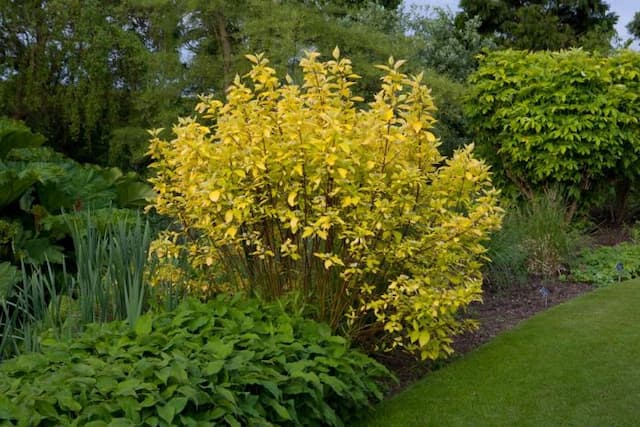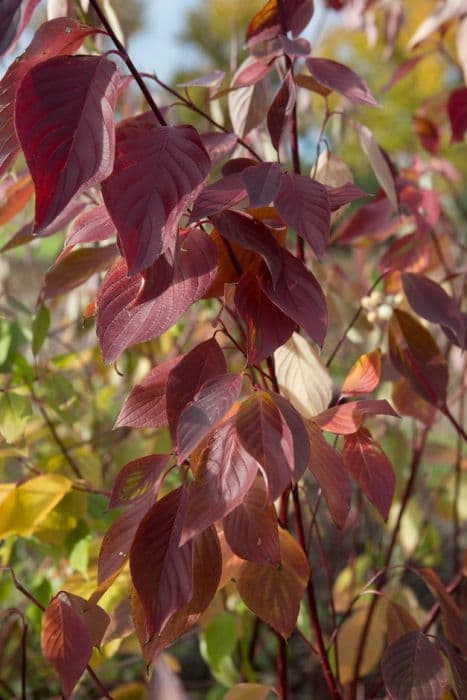Cornelian Cherry Dogwood Cornus mas 'Golden Glory'











ABOUT
Golden Glory is a deciduous shrub known for its striking ornamental features throughout the year. In late winter to early spring, it boasts a profusion of bright yellow flowers that cover its branches, radiating a vibrant glow even on the dullest of days. These star-shaped flowers emerge before the foliage, making the display particularly striking against the bare branches. As spring progresses, the shrub's foliage unfurls into a rich green color. The leaves are oval to oblong, with a smooth surface and a slightly wavy margin, giving the plant a lush, dense appearance. The foliage often transitions to attractive shades of reddish-purple in the fall, contributing to the plant's seasonal interest. Following the flowering period, Golden Glory may produce small, oblong red fruits that are cherished by birds and other wildlife. These fruits can persist into the winter, offering a pop of color against the backdrop of the bare branches after the leaves have fallen. Overall, the plant exhibits a well-branched, rounded form that serves as an excellent backdrop in garden landscapes. Its dense branching pattern and seasonal interest make it a popular choice for ornamental hedging or as a statement specimen within garden beds and borders.
About this plant
 Names
NamesFamily
Cornaceae
Synonyms
Cornelian Cherry, Cornelian Cherry Dogwood, European Cornel, Cornelian Cherry 'Golden Glory'
Common names
Cornus mas 'Golden Glory'.
 Toxicity
ToxicityTo humans
The Cornelian cherry is generally considered non-toxic to humans. The fruit is edible and often used in jams, syrups, and liqueurs. However, as with any plant, individual allergies or sensitivities could occur. Eating large quantities of any plant material may cause digestive upset. There is no well-documented evidence of severe toxicity from ingesting the wood or leaves, but they are not typically consumed.
To pets
The Cornelian cherry is also generally considered non-toxic to pets. The edible fruits are unlikely to harm dogs or cats if ingested in small quantities. However, pets should not be allowed to eat large amounts of any non-food plant material, including the leaves or wood of the Cornelian cherry, as it could potentially cause gastrointestinal upset or obstruction. Always monitor your pets around plants and seek veterinary attention if you observe unusual behaviors or symptoms following ingestion.
 Characteristics
CharacteristicsLife cycle
Perennials
Foliage type
Deciduous
Color of leaves
Green
Flower color
Yellow
Height
15-20 feet (4.5-6 meters)
Spread
15-20 feet (4.5-6 meters)
Plant type
Shrub
Hardiness zones
5
Native area
Southern Europe to Western Asia
Benefits
 General Benefits
General Benefits- Ornamental Appeal: Cornelian cherry provides visual interest with its bright yellow flowers in early spring, before the foliage emerges, and its attractive exfoliating bark adds winter appeal.
- Wildlife Habitat: The fruits are a valuable food source for birds and other wildlife, while the dense foliage offers shelter and nesting sites.
- All-Season Interest: With flowers in spring, edible fruit in late summer, colorful foliage in fall, and textured bark in winter, it offers year-round interest in the landscape.
- Low Maintenance: Once established, it requires minimal care, proving to be drought-tolerant and typically free from serious pests and diseases.
- Edible Fruit: The bright red berries are edible and can be used in a variety of culinary applications, such as syrups, preserves, and baked goods.
- Drought Tolerance: It is capable of withstanding periods of dry conditions once it has been established, reducing the need for supplemental watering.
- Shade Tolerant: While it prefers full sun, Cornelian cherry can also grow well in partial shade, making it versatile for different garden locations.
- Urban Adaptation: It is tolerant of urban pollution and can thrive in city environments, making it suitable for urban landscaping.
- Soil Adaptability: Cornelian cherry can adapt to a wide range of soil types, whether acidic, alkaline, loamy, sandy, or clay, as long as the soil is well-drained.
- Hardiness: It is cold-hardy and can tolerate winter temperatures in USDA hardiness zones 4 through 8, making it suitable for a variety of climates.
- Compact Size: The 'Golden Glory' cultivar is more compact and orderly than the species, making it suitable for small gardens and landscape areas.
 Medical Properties
Medical Properties- Antioxidant – Cornus mas 'Golden Glory' contains high levels of antioxidants which are believed to help in neutralizing free radicals in the body.
- Anti-inflammatory – Extracts from the plant have been used to reduce inflammation.
- Vitamin C – The fruit is a good source of Vitamin C which is essential for immune system function and skin health.
 Air-purifying Qualities
Air-purifying QualitiesThis plant is not specifically known for air purifying qualities.
 Other Uses
Other Uses- Cornelian cherry fruit leather – The fruits can be boiled down and pureed to create a sweet and tangy fruit leather, a traditional snack in some cultures.
- Natural dye – The bark of the Cornelian cherry can be used to make a dye for fabrics, yielding shades of brown and gray.
- Woodturning – The hard wood of Cornelian cherry is valued for woodturning and can be used to make tool handles and small carved objects.
- Ink making – The tannins present in the bark and leaves can be used to make natural ink.
- Bonsai – Due to its interesting structure and vibrant early spring blooms, Cornelian cherry can be cultivated as a bonsai plant.
- Fishing rods – In some traditional practices, the flexible yet strong branches are used to make fishing rods.
- Wildlife shelter – The dense foliage provides excellent shelter for birds and other small wildlife seeking refuge or nesting sites.
- Wood for smoking food – The wood chips of Cornelian cherry can be used for adding a distinct flavor when smoking meats and cheeses.
- Wooden jewelry – The dense, fine-grained wood can be crafted into beads or pendants for making natural jewelry.
- Photography and painting muse – The early spring blossoms and bright summer fruits provide inspiring subjects for artists and photographers.
Interesting Facts
 Feng Shui
Feng ShuiThe Cornelian Cherry is not used in Feng Shui practice.
 Zodiac Sign Compitability
Zodiac Sign CompitabilityThe Cornelian Cherry is not used in astrology practice.
 Plant Symbolism
Plant Symbolism- Renewal: The Cornelian cherry, blooming early in spring, represents the renewal of life and the end of the winter season.
- Protection: In some cultures, Cornelian cherry is believed to have protective qualities, often planted near homes to safeguard against misfortune.
- Durability: With its hard wood and resilient nature, the Cornelian cherry symbolizes strength and the ability to withstand challenges.
 Water
WaterFor the Cornelian cherry 'Golden Glory', it needs consistent moisture, especially during dry spells. In the first growing season, water deeply once a week to establish an extensive root system. Use about 1-2 gallons per watering session, depending on the size and soil conditions. As it matures, water needs may lessen, but the tree still requires regular watering, particularly in prolonged periods of drought or extreme heat. Avoid overwatering and ensure proper drainage to prevent root rot.
 Light
LightThe Cornelian cherry 'Golden Glory' thrives in full sun to partial shade. An ideal spot is where it can receive at least four to six hours of direct sunlight daily while being protected from the harsh afternoon sun. So, a location with morning sun and dappled afternoon shade could be perfect to promote a healthy growth and abundant flowering.
 Temperature
TemperatureThe Cornelian cherry 'Golden Glory' is hardy and can withstand a range of temperatures. It is tolerant to cold, surviving temperatures down to -30 degrees Fahrenheit, and can handle the heat up to 100 degrees Fahrenheit. Ideally, this deciduous shrub prefers temperatures between 60 and 75 degrees Fahrenheit for optimal growth and fruit production. Ensure that the plant is mulched well to help protect roots in extreme temperatures.
 Pruning
PruningPruning the Cornelian cherry 'Golden Glory' is essential for maintaining shape and removing dead or diseased branches. It is best to prune in late winter or early spring before new growth starts. Thinning out overcrowded branches every few years helps to ensure adequate light and air circulation, which can reduce disease incidence. Occasional removal of older stems also encourages the growth of young, more vigorous branches with better flower and fruit production.
 Cleaning
CleaningAs needed
 Soil
SoilThe Cornelian Cherry (Cornus mas 'Golden Glory') thrives in well-draining soil that is rich in organic matter. A soil mix that contains equal parts loamy soil, peat moss or compost, and coarse sand or perlite is ideal. The preferred soil pH for the Cornelian Cherry is slightly acidic to neutral, ranging from 5.5 to 7.0.
 Repotting
RepottingCornelian Cherry ('Golden Glory') is a woody shrub and doesn’t require frequent repotting. It is typically planted outdoors and doesn't need repotting if given sufficient space to grow. If grown in a container, repotting might be necessary every 3 to 5 years to provide fresh soil and additional room for root growth.
 Humidity & Misting
Humidity & MistingThe Cornelian Cherry ('Golden Glory') is adaptable to a wide range of humidity conditions and does not require high humidity. Average outdoor humidity levels are sufficient for this plant, as it is tolerant of the seasonal changes typical of temperate climates.
 Suitable locations
Suitable locationsIndoor
Ensure bright light, cool temps, and well-draining soil for indoor growth.
Outdoor
Plant in full sun to partial shade in well-draining soil.
Hardiness zone
5-8 USDA.
 Life cycle
Life cycleCornelian cherry 'Golden Glory' begins its lifecycle as a dormant seed that requires stratification to break dormancy and germinate, typically in spring. Once germinated, the seedling grows into a young plant with a strong taproot and starts developing leaves and a woody stem. As it matures, it enters a vegetative stage, characterized by the growth of foliage and roots, and eventually forms a multi-stemmed shrub or small tree. After a few years of growth, the Cornelian cherry 'Golden Glory' reaches reproductive maturity and begins to produce yellow flowers in late winter to early spring before the leaves unfold, which are pollinated by insects. Following pollination, it develops small, oval red fruits by late summer that are edible and attractive to wildlife. Throughout its lifetime, the plant experiences annual cycles of growth, flowering, fruiting, and dormancy, usually with an increase in size and production each year until it reaches its full mature size, after which it maintains size through a balance of new growth and natural attrition of older stems.
 Propogation
PropogationPropogation time
Early Spring
The Cornelian cherry 'Golden Glory' can be propagated most popularly through softwood cuttings. This technique is typically performed during the late spring or early summer when new growth is still supple. To propagate, choose a healthy, non-flowering stem and cut a 4-6 inch (about 10-15 cm) length, ensuring that there are at least two or three sets of leaves. The bottom set of leaves should be removed and the cut end dipped in a rooting hormone to encourage root development. The cutting is then placed in a well-draining soil mix, ensuring that the leaf nodes where the leaves were removed are buried. The environment should be kept humid by covering the cutting with a plastic bag or dome and placed in indirect light. Roots usually develop within 4 to 8 weeks, after which the new 'Golden Glory' plant can be gradually acclimated to less humid conditions before transplanting.

![Dogwood [Baton Rouge]](/_next/image?url=https%3A%2F%2Fplants-admin.emdemapps.com%2Fimages%2Fplants%2F%2Fimages%2F604b59cf0fefd.png&w=640&q=75)

![Dogwood [Ivory Halo]](/_next/image?url=https%3A%2F%2Fplants-admin.emdemapps.com%2Fimages%2Fplants%2F%2Fimages%2F604b535cbcb9a.png&w=640&q=75)





![Dogwood [Venus]](/_next/image?url=https%3A%2F%2Fplants-admin.emdemapps.com%2Fimages%2Fplants%2F%2Fimages%2F604b58a531da1.png&w=640&q=75)